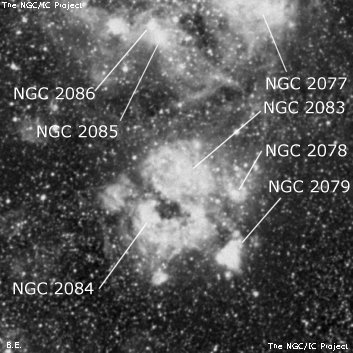
NGC 2083 is situated in the northeast section of the curving "S" shaped NGC 2078/79/83/84 complex (LMC-N159 and OB-association LH 105). This complex shares the same field with two additional bright emission regions - NGC 2085/86 4' N and NGC 2077/80 ~5.5' NNW (LMC-N160), and the combined complex forms a superb field of bright HII regions ~35' SSE of the center of the Tarantula Nebula. Although Herschel assigned 4 NGC numbers within LMC-N159, I logged at least 7 different brighter knots (see NGC 2084 for more).
John Herschel discovered NGC 2083 = h2952 (along with numerous other objects in this HII complex) on 23 Dec 1834 and recorded "the north following nucleus of the complex group of Plate III, figure 4, from drawing." Herschel's excellent sketch shows a complex object with 7 condensations or nuclei, involved in nebulosity. The four NGC objects in this grouping are NGC 2078, 2079, 2083 and NGC 2084.
600/800mm - 24" (4/10/08 - Magellan Observatory, Australia): at 214x and UHC filter, NGC 2083 appeared as a bright, large, slightly elongated glow ~1.8' diameter, surrounding a mag 12.5 star (O-class supergiant). A brighter knot is embedded within the glow on the west side (LMC-N159I) on a line with NGC 2078. Removing the filter, the bright central star has a companion at ~7" and several other mag 14 stars are embedded in the periphery of the glow.
Notes by Steve Gottlieb